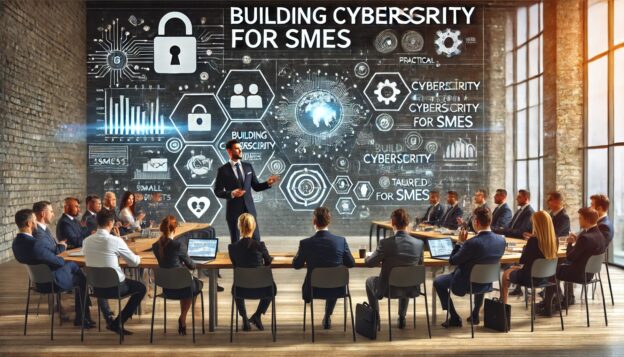In this fireside chat, Jamie Akhtar shared the journey of building Cyber Smart, his lessons in scaling, fundraising, and pivoting the business to focus on cyber hygiene for SMEs. Learn how he navigated the ups and downs of the startup world.
Starting and scaling a cybersecurity company in today’s competitive landscape is no small feat. Jamie Akhtar of Cyber Smart shared the highs and lows of his journey during a recent Cyber Runway: Scale session provided by the Department for Science, Innovation & Technology and hosted by Plexal, where I attended on behalf of Cyber Tzar, the Enterprise Supply Chain Risk Management platform. From navigating six funding rounds to pivoting his go-to-market strategy, Jamie offered valuable lessons on customer acquisition, fundraising, and building a sustainable business, insights that are must-reads for any founder in the space.
Contents
Founders Fireside with Jamie Akhtar
This video is publicly available on the Plexal YouTube playlist for the Cyber Runway programme.
Key Insights and Findings
Here are the key insights and findings from the Cyber Runway Scale session “Founders Fireside with Jamie Akhtar“. These insights from Jamie Akhtar’s experience at Cyber Smart reflect the challenges and nuances of scaling a cybersecurity company, managing growth, building strong channel partnerships, and navigating the complex world of VC-backed startups.
Background of Cyber Smart
- Jamie Akhtar has been involved in tech and cybersecurity for over 15 years, with Cyber Smart being his most recent venture. The company helps SMEs get and stay secure, focusing on basic cyber hygiene and making cybersecurity accessible to small and medium-sized businesses.
- Cyber Smart has raised around £20 million across six funding rounds, and the company has gone through significant shifts, including changes in team structure and go-to-market strategy. Initially targeting direct sales, the company pivoted to a channel-first approach.
Challenges with Growth and Scaling
- Jamie emphasized that Cyber Smart’s journey has been slower than expected, with the company reaching just over 5,000 customers, far fewer than initial projections.
- One major shift came from transitioning the go-to-market strategy to focus on resellers and channel partners. This pivot was driven by better economics, including improved customer acquisition costs and net revenue retention.
Insights on Fundraising
- Cyber Smart was initially bootstrapped but soon realized the need for external capital to scale. They raised an Angel round and later a Series A, followed by other rounds to support growth.
- Jamie shared his experiences on fundraising, noting that once a company begins the VC path, it’s hard to step off due to expectations of growth. He recommends bootstrapping as long as possible before turning to VC money, as this allows more freedom and fewer external pressures.
Lessons in Hiring and Team Management
- Jamie discussed significant team changes, noting that the executive team shrunk from five to two members. This restructuring was necessary as the company’s needs changed, especially after raising significant capital.
- He highlighted the importance of recognizing when key team members may no longer be the right fit as the company grows and evolves, despite the challenges of managing these changes.
Focus on Cyber Hygiene
- Cyber Smart focuses on providing a “complete cyber confidence” package, emphasizing cyber hygiene practices like device security and staff training, which are critical for reducing risk.
- They primarily target SMEs (with 10–100 employees), offering cybersecurity solutions that address the basics but remain essential for many small businesses lacking internal cybersecurity expertise.
Challenges in Customer Acquisition
- One major difficulty was scaling through digital marketing. Initially, Cyber Smart spent heavily on online advertising, but they hit a plateau where the cost per acquisition continued to rise.
- Shifting to a channel-first strategy, where managed service providers (MSPs) resell their products, has been a more efficient model. This move allowed Cyber Smart to grow faster and with better economics than through direct sales alone.
Importance of Channel Partnerships
- Building a channel route to market requires dedication and a substantial investment of time and resources. Jamie emphasized that companies should not approach channel sales as a side project, but instead, fully commit if they want it to succeed.
- Cyber Smart built a successful channel by cold-calling MSPs, conducting hundreds of demos, and converting a portion into partners. This process took years, and success required continuous support and listening to partner feedback.
Customer-Focused Growth
- Jamie underscored the importance of spending as much time as possible with customers in the early stages. Building proof of concepts (POCs) and gathering real-world feedback is essential for product development and refining go-to-market strategies.
Fundraising Advice
- Jamie advised founders to stay true to their vision when seeking investors and be wary of compromising on values. He also emphasized the importance of transparency and honesty during fundraising.
- He shared insights about the “VC train,” explaining that once a startup raises venture capital, there are heightened expectations for growth, which can influence company strategy. Startups should carefully consider the trade-offs of raising external capital.
Conclusion
The path to building a successful cybersecurity company is filled with challenges, but as Jamie Akhtar demonstrated, it’s all about adaptability, focus, and customer-centric growth. By staying true to your vision and learning from every step of the journey, startups can overcome the obstacles that come their way and achieve lasting success.
